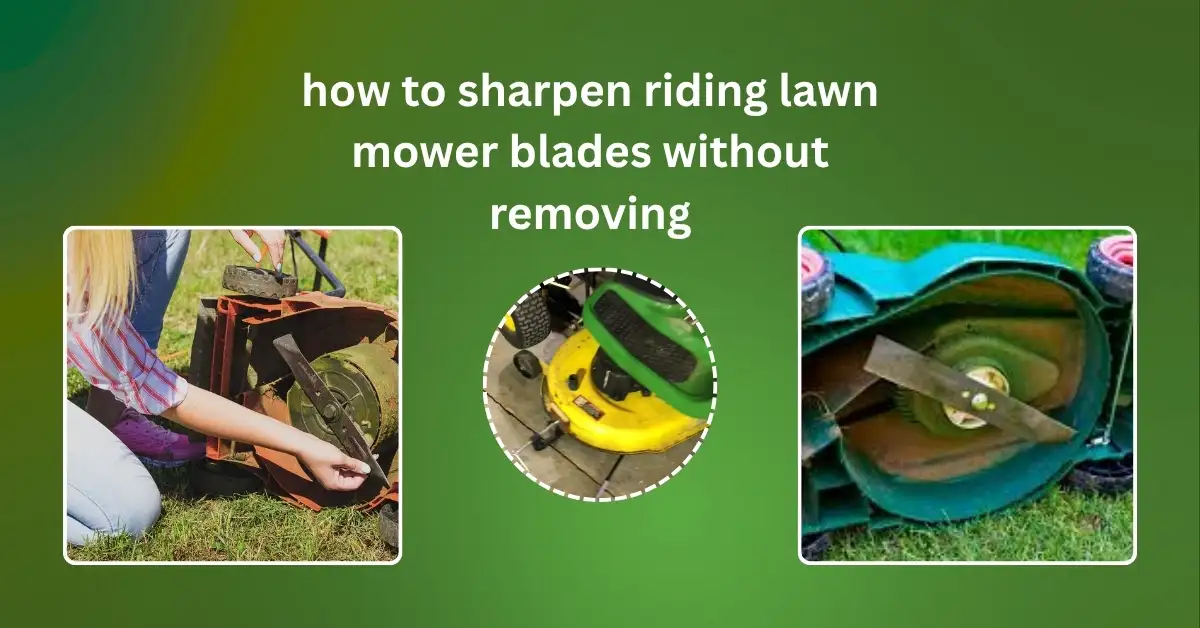How To Sharpen Riding Lawn Mower Blades Without Removing

Have you ever wondered how to sharpen riding lawn mower blades without removing them? I did too. I didn’t want to mess with bolts or flip the whole mower over.
So I tried sharpening the blades while they were still on. It saved me time—and it worked better than I thought. In this guide, I’ll show you how to do it step by step, using tools you might already have. Let’s get into it.
Can You Sharpen Riding Mower Blades Without Removing Them?
Yes, you can sharpen riding mower blades without removing them—and it works surprisingly well if you do it right. I’ve done it a few times now, and let me tell you, it’s a real time-saver when you just want to get back to mowing without dragging out tools and crawling under your mower for an hour.
The key is making sure the blades are still in good shape. If they’re just dull, sharpening them in place is fine. But if the blades are bent, cracked, or badly chipped, you’ll need to take them off and replace or fully repair them. No amount of sharpening can fix a blade that’s past its prime.
I learned early on that rushing this can lead to uneven cuts—or worse, stress on the engine. So always check the blade condition first. If it looks okay, you’re good to go. Just take your time, follow the steps, and make sure your mower is stable before you start.
Short answer? Yes—you can sharpen riding mower blades in place, as long as they’re not damaged. Just use the right tools and stay safe.
Best Tools to Sharpen Lawn Mower Blades Without Removing
You don’t need fancy gear to sharpen your mower blades in place—but the right tools make a big difference. I’ve tested a few over the years, and some definitely make the job easier and safer.
- Angle Grinder
This is my go-to. I use it with a flap disc (you can also use a metal grinding wheel). It’s fast, powerful, and easy to control once you get the hang of it. You can grab one at most hardware stores or online. Just make sure the disc is clean and not worn down.
Best for: quick sharpening with minimal effort. - Rotary Blade Sharpener
These attach to a power drill and are pretty user-friendly. They have a built-in guide to help you keep the right angle. If you’re new to blade sharpening, this is a good starting point. You can find them at Lowe’s, Home Depot, or Amazon.
Best for: beginners who want a simple, guided option. - Dremel Tool
Great for touch-ups or tight spots. It’s smaller, so it’s not ideal for deep sharpening, but it’s handy if you just need to freshen up the edge. I keep one around for detailed work.
Best for: light sharpening and small corrections. - Blade Balancer
After sharpening, it’s important to check the balance. An unbalanced blade can shake the whole mower and wear out parts faster. You can use a store-bought balancer or hang the blade on a nail to check if it tilts.
Best for: making sure your mower runs smooth and safe. - Safety Gear
This is non-negotiable. Always wear gloves, goggles, and ear protection. I also use jack stands or solid blocks to hold the mower steady. Some folks use ramps. Whatever you choose, make sure it’s solid before you crawl under.
Best for: keeping your hands, eyes, and ears protected while you work.
Short answer? These tools help you sharpen blades safely and effectively—without taking them off the mower. My personal favorite is the angle grinder with a flap disc. It’s fast, smooth, and gets the job done right.
Step-by-Step: Sharpening Riding Mower Blades In Place
If you’re like me, you want a better cut without turning this into a big weekend project. Good news—you can sharpen your riding mower blades in place if you go step by step and stay safe. Here’s exactly how I do it:
Step 1: Prep the Mower
Short answer? Safety comes first—always.
Start by disconnecting the spark plug. This keeps the engine from accidentally turning over while you’re working underneath. Next, engage the parking brake so your mower doesn’t roll on you.
Now raise the mower high enough to access the blades. I use jack stands and wood blocks for stability, but ramps can work too. Just double-check everything is solid before you crawl under. I always give it a shake—if it wobbles, I readjust.
Pro tip: Never trust just a hydraulic jack. Always block the wheels and use backup support.
Step 2: Clean the Blades
Quick tip: Dirty blades won’t sharpen well.
Grab a wire brush or scraper and knock off any stuck-on grass, mud, or gunk. The cleaner the blade, the easier it is to see what you’re working with.
I’ve made the mistake of skipping this part once. The grinder just skidded over the buildup—and I ended up having to stop and clean anyway. Save yourself the hassle and get the gunk off first.
Step 3: Sharpen the Blades Carefully
This is where the magic happens—but take it slow.
Use your preferred tool (I go with an angle grinder and flap disc). Match the original angle of the blade edge, usually around 30 degrees. Start at one end and make smooth, even passes across the cutting edge.
Answer in a nutshell: Use steady pressure and don’t grind too hard—you’re sharpening, not reshaping.
You don’t want to overheat the blade, so keep it moving. I usually do 3–4 passes, then check the sharpness. If it feels like a butter knife, keep going. If it feels like a steak knife, you’re good.
Step 4: Check for Balance
This step is easy to skip—but don’t.
After sharpening, the blade should be evenly ground on both sides. That can wear down the bearings and shorten your mower’s life.
I use a simple blade balancer I picked up online, but in a pinch, you can hang the blade on a nail. If it tilts to one side, you’ll need to grind a bit more on the heavier end.
Why it matters: A balanced blade means a smoother ride and less stress on your mower.
Step 5: Reassemble and Test
Now lower the mower carefully and reconnect the spark plug.
Start it up and mow a small patch of grass. If it cuts clean and sounds smooth, you’re all set. If the grass looks frayed or the mower vibrates, double-check your sharpening and balance.
My rule of thumb: If it looks like someone tore the grass instead of cutting it, the blade needs another pass.
My Experience Sharpening Blades Without Removal
What I Learned From Doing This Myself
The first time I tried sharpening my mower blades without taking them off, I was a little unsure. I didn’t know if it would work—or if it would be safe. But I didn’t want to mess with bolts or flip the mower over. So I gave it a shot.
Quick answer? It took me about 45 minutes, and the results were better than I expected.
The hardest part was getting the mower stable. I used jack stands and wood blocks to hold it in place. Once it felt solid, I crawled under and got to work. I cleaned the blades with a wire brush, then grabbed my angle grinder.I used smooth, even passes and followed the blade’s edge. I didn’t press too hard—just enough to bring the edge back. After a few passes, it felt sharp again. The blade looked clean and ready.
What went well? The mower cut much better after I was done. The grass looked smooth, not torn.
What I’d change next time? I would check the blade balance before putting everything back together. I skipped that once, and the mower shook more than it should have. A balanced blade makes a big difference.
Bottom line: This method works. It saves time, and it’s easy once you try it. You don’t need to be a pro. Just go slow, be safe, and follow the steps.
If I can do it, so can you.
Tips to Keep Your Blades Sharper Longer
How I Keep My Blades Sharp and My Grass Looking Good
Want to make your mower blades stay sharp longer? It’s not just about how you sharpen them—it’s how you treat them between mows. I learned this the hard way after chewing up a set of blades way too fast. Here’s what’s worked best for me.
Mow when the grass is dry.
Sounds simple, but this one makes a big difference. Wet grass clumps up under the deck and sticks to the blades. That buildup dulls the edge faster and makes the mower work harder.
Quick tip: I wait until mid-morning when the dew dries off. The cut is cleaner, and I don’t have to scrape off soggy clumps later.
Clean the blades after each mow.
Trust me—this is a 2-minute job that saves you hours later. I used to skip it, thinking it didn’t matter. But after a while, I noticed the blades looked rough and rusty. Now I keep a wire brush or putty knife in the garage and give the underside a quick once-over after mowing.
Short answer: A clean blade stays sharper and rust-free much longer.
Avoid hitting sticks, rocks, or roots.
I once hit a hidden tree root and chipped the blade so bad I had to replace it. Since then, I walk the yard before I mow. I clear out big sticks and check for anything the blade might smack into. It takes five minutes and saves a ton of hassle.
Pro tip: Even small hits can dent or dull the edge—and once it’s damaged, no amount of sharpening will fully fix it.
Sharpen every 20–25 hours of use.
This is the sweet spot for most riding mowers. I used to wait until the grass looked bad, but by then, the blade was already doing damage. Now I keep a little notebook and jot down the hours each time I mow. It helps me stay ahead of wear and keeps my lawn looking fresh.
Simple rule: Don’t wait for ragged grass—sharpen on a schedule.
Bottom line?
If you treat your blades well, they’ll return the favor. Clean cuts, less engine strain, and a yard that looks way better with less effort. It’s like keeping your kitchen knives sharp—you don’t notice how dull they were until you use a sharp one again.
Final Thoughts
So—can you sharpen riding mower blades without removing them? Absolutely. And if you do it right, it’s not just safe—it’s smart.
When I first gave this method a shot, I wasn’t sure it would work. But now it’s my go-to for regular maintenance. It saves me time, keeps my mower running smoother, and gets my lawn looking sharp without the hassle of blade removal. Honestly, once you get the hang of it, it feels like a little lawn care hack that not enough people talk about.
Short answer? Sharpening in place works—and it’s a major time-saver for anyone who mows regularly.
That said, safety’s still the name of the game. Always make sure the mower’s stable, the blades aren’t damaged, and you’re geared up properly. Take your time, follow the steps, and you’ll get the hang of it quickly.
I’d love to hear how it goes for you. Have you tried sharpening without removing the blades? Got tips of your own or questions you’re stuck on? Drop them in the comments—I’m always up for swapping mower stories and helping out where I can.
Bottom line: If I can do it, so can you. Just stay safe, go slow, and enjoy the clean cut. Your lawn (and your mower) will thank you.
Read More: Is Your Riding Lawn Mower Near the End of Its Life? Signs & Lifespan Info
